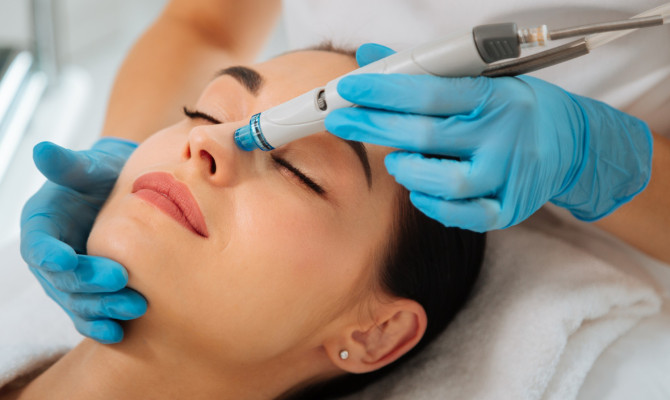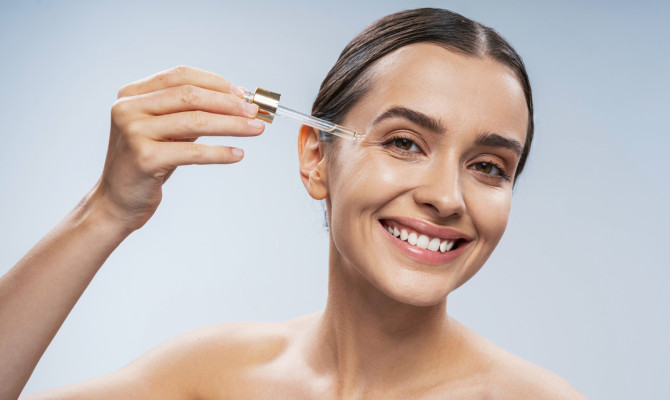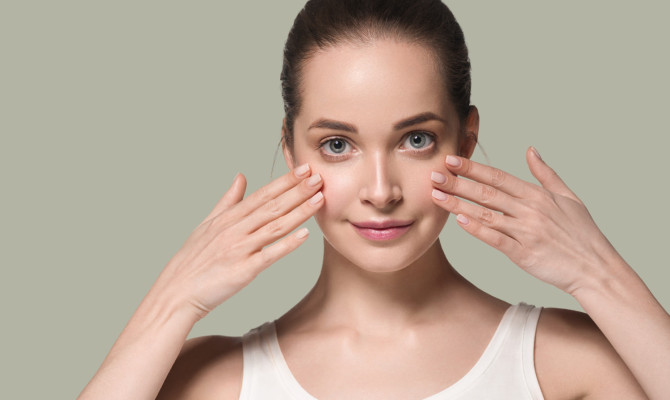Botox for Chin: A Complete guide about the Procedure & Effectiveness

- Botox
- 08 Sep 2023
Introduction
What is Botox?
The toxin required for the production of Botox is produced by the bacteria Clostridium botulinum. The toxin that causes botulism, a potentially deadly type of food poisoning. Soreness, bleeding, or inflammation at the site of the injection are the most frequent side effects. People might also have headaches, vomiting, and flu-like symptoms.
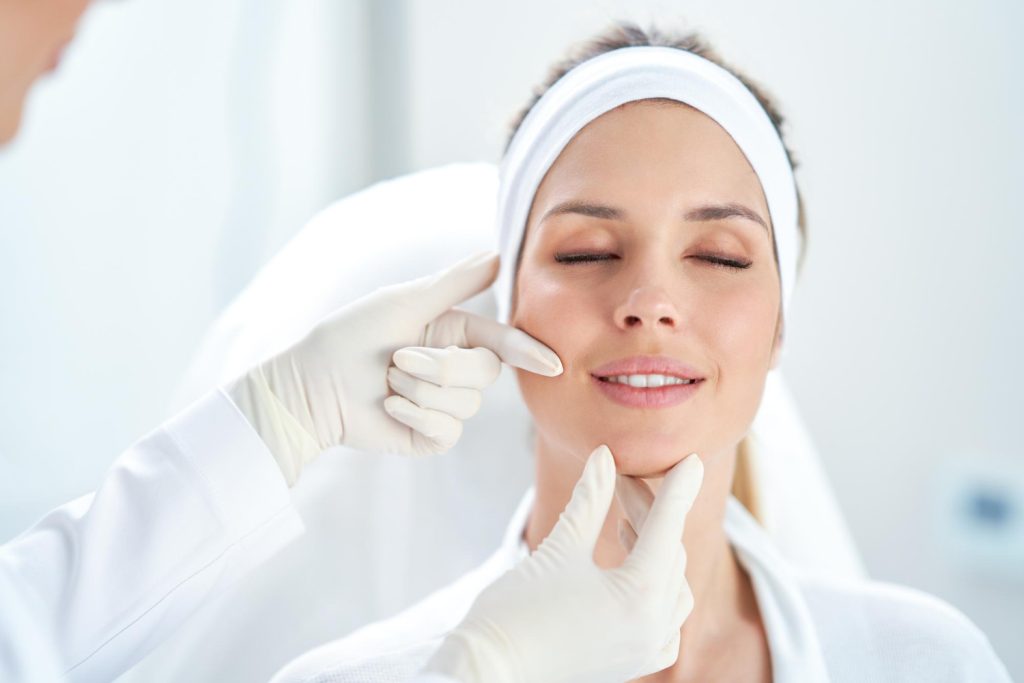
Uses
Uses of Botox
Since many years, blepharospasm, a condition known as cervical dystonia, headaches, hyperhidrosis, and muscle spasms have all been treated using botulinum toxin.
In tiny doses, doctors utilize it to treat a variety of health issues, including:
- Temporary wrinkle reduction, and facial improvement
- Extreme underarm perspiration
- A neurological condition called cervical dystonia causes violent neck and shoulder muscle contractions
- Uncontrollable blinking
- Altered eyes
- Persistent migraine
- Uncontrollable bladder [1]
Mechanism of Action
How does Botox work?
- Botox injections work by weakening or paralyzing specific muscles or by blocking specific nerves.
- The consequences can last somewhere between three and twelve months, depending on what the patient is treating.
Indications
What Aesthetic Conditions Can Botox Treat?
Symptoms of aging are treated with cosmetic Botox injections. Botox injections can reduce the fine lines and wrinkles on several parts of the face, including:
- Eyes (crow’s feet)
- Nose
- Forehead
- Eyebrows
- Chin
- Lips
- Jawline
- Neck [ 2]
Considerations
Things to Consider Before Undergoing Botox
- Make sure the list of prescription drugs and dietary supplements you take is up to date for your doctor.
- The possibility of bleeding at the injection site is increased by some drugs.
- These include (NSAIDs) nonsteroidal anti-inflammatory medications and blood thinners.
- You are more prone to bruising and redness after drinking alcohol. So, for 24 hours before a procedure, abstain from alcohol. [1]
- The women who are pregnant and are lactating should not use Botox. [1]
Storage
How is Botox Stored?
- Botox can be stored for up to 24 months for the 50 units as well as 200 units vials and up to 36 months for the 100 units vial, Botox unopened vials should be kept in a refrigerator (2° to 8°C).
- After the vial’s expiration date, do not use it.
- Within 24 hours of reconstitution, administer Botox; during this time, keep reconstituted Botox in the fridge (2° to 8°C). [5]
- Botox that has been reconstituted should be colorless, transparent, and impurity-free.
Procedure
Administration of Botox
Botox for Double Chin
- Clinically, this condition is characterized by a moderate-to-severe fullness or convexity below the jawline, commonly known as a double chin appearance.
- The U.S. FDA has only approved the procedure of injection lipolysis for the removal of persisting submental fat.
- Few doctors inject facial fats such as the cheek, chin, and jaw fat pads for off-label purposes.
- These indications have unpredictable effects, and the techniques used are not as standardized as those used for submental fat injection.
- There are no absolute limitations to the technique.
- In case of any infection at the injection site, Botox treatment can be avoided.
- Patients with excessive expectations and those who are unwilling to accept the procedure’s recovery period should not undergo it. [3]
Post-treatment Care
- From two days to two weeks after the injection, patients may suffer moderate swelling, stiffness, and pain as an indication of inflammation. For the same, patients can align themselves.
- Cold compresses are useful in relieving pain. Anti-inflammatory medications used orally are rarely utilized.
- For the following 48 hours, patients are urged not to massage the treated region.
- After four weeks, patients can often be followed up with to evaluate the effects and schedule additional sessions based on their needs. [3]
Botox for Wrinkles
- The most popular cosmetic procedure in the United States is botulinum toxin injection for the treatment of facial wrinkles, and it is one of the most popular entrance procedures for practitioners looking to add aesthetic treatments. [4]
- Injections of botulinum toxin, particularly in the top third of the face, provide consistent results, have few side effects, and are linked to high patient satisfaction.
- It has been proven as the most reliable method of treating wrinkles on the top third of the face.
- It is also applied to the lower two-thirds of the face, but this is a more sophisticated and technically difficult treatment. [4]
Post-treatment Care
- Following treatment, patients are instructed to avoid lying down for four hours.
- On the day of treatment, they are encouraged to abstain from activities that make them flush, like strenuous exercise, drinking alcohol, and using hot tubs.
- They are also cautioned against massaging or applying heat to the treatment region. [4]
Side Effects
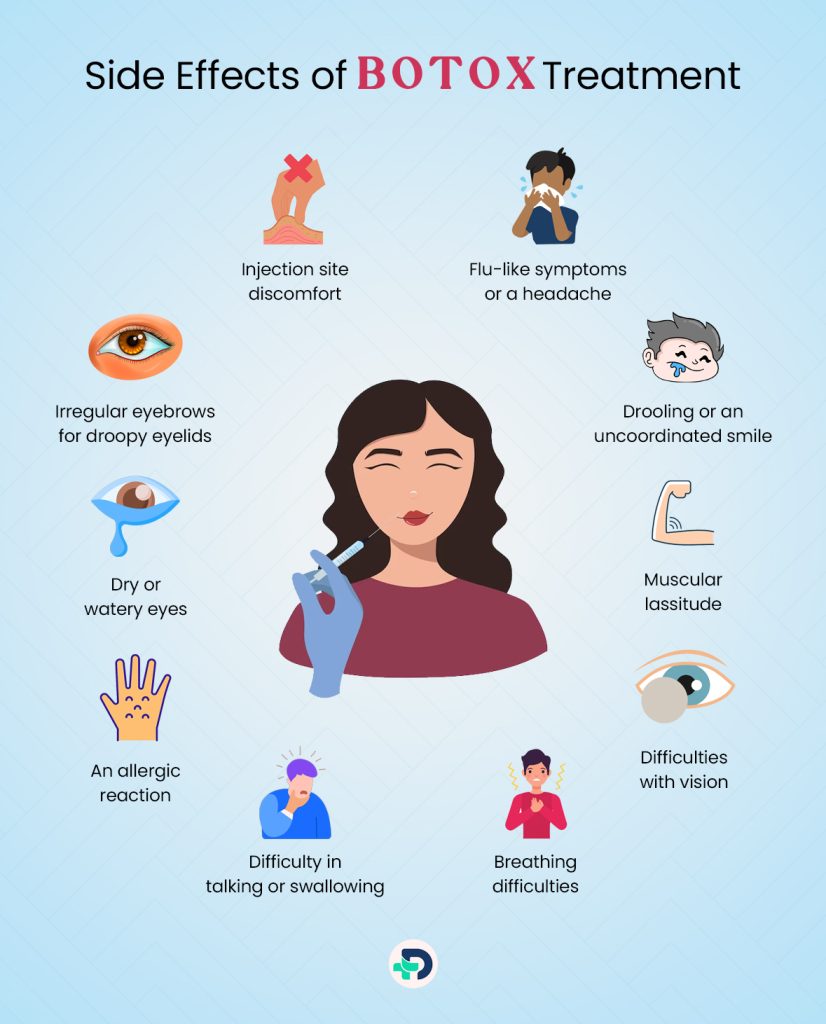
Adverse Effects of Botox Treatment
Botox injections are mostly safe when given by a licensed and registered healthcare provider. The procedure could result in unwanted outcomes or even be hazardous if carried out incorrectly. Unwanted outcomes and potential negative effects include:
- Injection site discomfort, bruising, or edema
- Flu-like symptoms or a headache
- Irregular eyebrows for droopy eyelids
- Drooling or an uncoordinated smile
- Dry or watery eyes
- The injection location is infected [1]
There is a slight possibility that the medicine could reach parts of the body it should not and there may be symptoms from it. Call your doctor if you encounter any of these symptom’s hours or weeks after your surgery.
- Muscular lassitude
- An allergic reaction
- Difficulties with vision
- Difficulty in talking or swallowing
- Breathing difficulties
- Loss of control over the bladder
In general, doctors advise not to undergo Botox if a woman is lactating or expecting a child [2]
Precautions
Precautions for Botox
Hypersensitivity Reactions:
- There have been reports of severe and acute hypersensitivity reactions.
- Anaphylaxis, serum sickness, urticaria, soft tissue swelling, and dyspnea are a few of these reactions.
- If this sort of reaction happens, Botox injections should be stopped and the proper medical treatment should be started very once.
- Since just one fatal episode of anaphylaxis involving lidocaine as the diluent has been documented, the causative agent cannot be conclusively identified.
Neuromuscular Disorders:
- When receiving botulinum toxin, patients with neuromuscular junction disorders or peripheral motor neuropathy diseases should be constantly monitored.
- Patients who receive therapeutic doses of Botox may be more likely to experience clinically significant side effects, such as severe dysphagia and difficulty breathing. [5]
Complications
Possible Complications of Botox
Swelling:
- The most frequent symptoms are discomfort, soreness, and swelling, all of which will pass with time.
- When deoxycholic acid is administered alone, swelling and pain can endure for 10 to 14 days, but when deoxycholic acid and phosphatidylcholine are combined, the discomfort can last for as little as a week.
Damage to nearby blood vessels:
- Bruises or ecchymosis are relatively limited, result from damage to nearby blood vessels, and go away in a few days.
Nerve damage:
- The marginal mandibular nerve was damaged as a result of a large deoxycholic acid injection made close to the nerve.
- Clinically, it might cause an unbalanced smile. In most cases, it may be avoided by using proper injection techniques. Difficulty swallowing is a rare occurrence. [2]
Spreading of Toxin Effect:
- The symptoms, which could include asthenia, generalized weakness of the muscles, diplopia, difficulty swallowing, ptosis, dysphonia, dysarthria, urine incontinence, and respiratory issues, correspond with the system of action of botulinum toxin.
- These signs have been noted anywhere between hours and weeks following the injection. There have been instances of deaths linked to the spread of toxic effects like breathing and swallowing problems that can be fatal. [5]
Takeaway
Takeaway for Botox
The risk of having multiple Botox treatments is unknown. Many people discover that Botox considerably raises their general level of happiness. In order to have the best outcomes with botulinum toxin injections, patients should undergo Botox therapy after every three to six months. Find out if this therapy is appropriate to your needs by speaking with your healthcare professional. [2]
Any feedback on this article?
 This Articles content was accurate
This Articles content was accurate Very Informative Article
Very Informative Article I have a question or a comment
I have a question or a comment
 This article contains inaccurate content
This article contains inaccurate content This article was not helpful
This article was not helpful I have a question or a comment
I have a question or a comment
We appreciate your helpful feedback!
Checkout our social pages
References
-
MedlinePlus
Uses | Considerations | Side Effects
-
Cleveland Clinic
Indications | Side Effects | Complications | Takeaway
-
National Institutes of Health
Procedure | For Double chin
-
American Academy of Family Physicians
Procedure | For Wrinkles
-
Food and Drug Administration
Storage | Precautions | Complications














